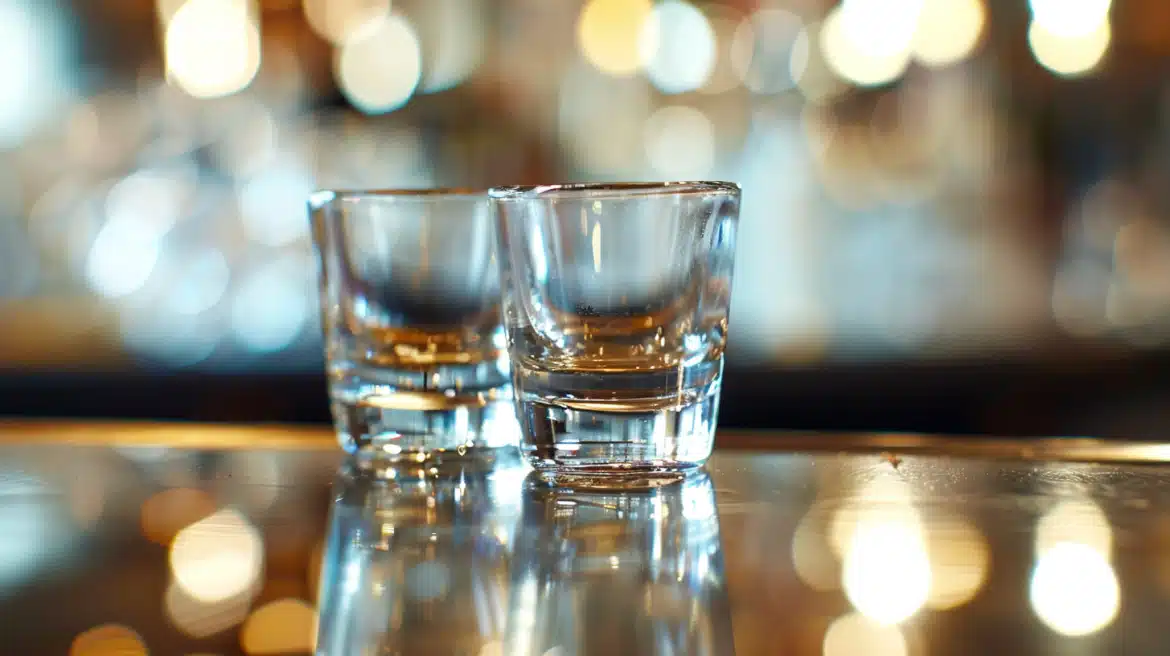Have you ever found yourself confused by the various shotglass sizes available? You’re not alone.
With options ranging from miniature 1-ounce glasses to larger 2-ounce jiggers, it can be challenging to know which size to use for different occasions.
That’s why we’ve created the ultimate guide to help you easily navigate the world of shot glasses.
This article explores the most common shot glass sizes, including mini shot glasses, standard 1.5-ounce glasses, and double shot jiggers.
We’ll also discuss the appropriate uses for each size and provide tips for selecting the perfect shotglass for your needs.
By the end of this guide, you’ll be an expert on shot glass sizes and ready to confidently serve and enjoy your favorite spirits.
What is a Shot Glass?
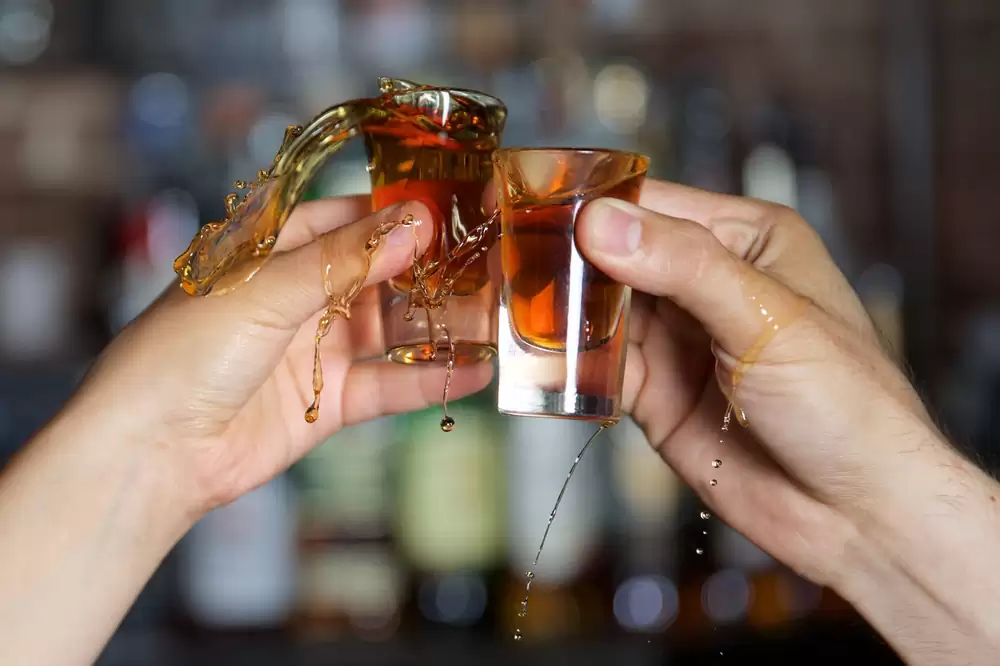
A small shot glass is designed to hold or measure spirits or liquor. It is typically used for consuming strong alcoholic drinks in small quantities or measuring ingredients when making cocktails.
Shot glasses come in various sizes, but the most common ones range from 1 to 2 ounces (30 to 60 ml).
Historical Background- Origin and Evolution
The exact origins of the shot glass are somewhat unclear, but it is believed to have emerged in the mid-1800s.
One popular theory suggests that “shot” comes from the old practice of using lead shot pellets to measure spirits. Another theory links the term to the small glasses used to serve whiskey samples to prospective buyers.
Over time, shot glasses transitioned from purely functional items in bars to becoming collectible objects and part of cultural practices worldwide.
As the popularity of spirits and cocktails grew, so did the variety and creativity of shot glass designs, reflecting changing tastes and trends.
Types of Shot Glasses
Shot glasses come in various types, each designed to serve a specific purpose in bars, restaurants, and for personal use.
The choice of shot glass can enhance the drinking experience, affect the flavor perception, and suit different types of drinks or occasions.
1. Jiggers
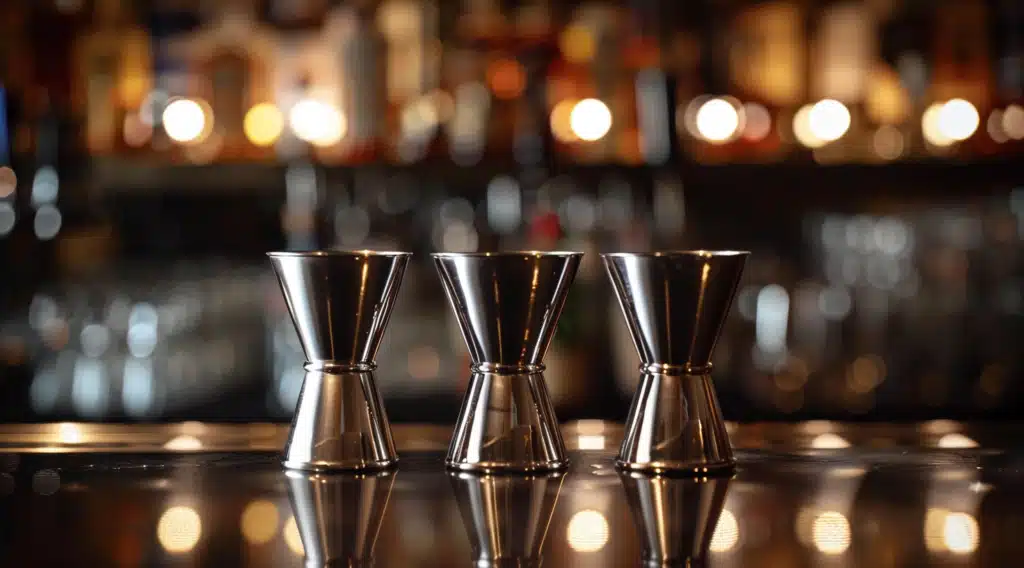
Jiggers are dual-sided shot glasses designed to measure spirits accurately, which is crucial in cocktail making.
They typically have two different capacities, such as 1 and 2 ounces (30 and 60 ml) or 3/4 and 1 1/2 ounces (22 and 44 ml).
Jiggers’ precise measurements ensure consistent and well-balanced cocktails, making them essential tools for professional bartenders and home mixologists.
2. Shooters
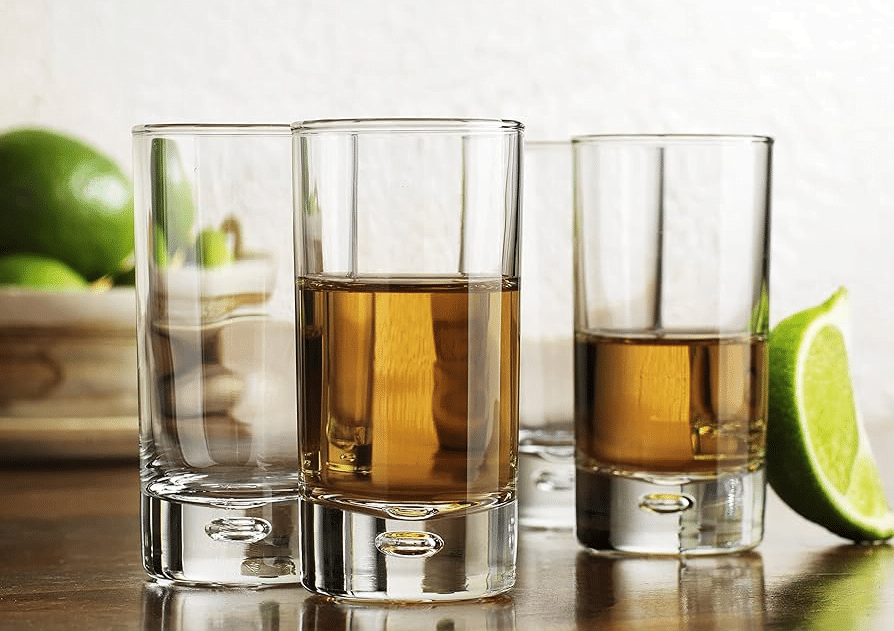
Shooters are taller and narrower than standard shot glasses, usually holding between 2 to 4 ounces (60 to 120 ml) of liquid. They are designed to quickly consume more complex mixed shots or straight liquors like tequila.
The elongated shape of shooters allows for the creation of visually appealing layered shots, where different liqueurs or spirits are carefully poured on each other to create distinct layers.
3. Novelty Shot Glasses
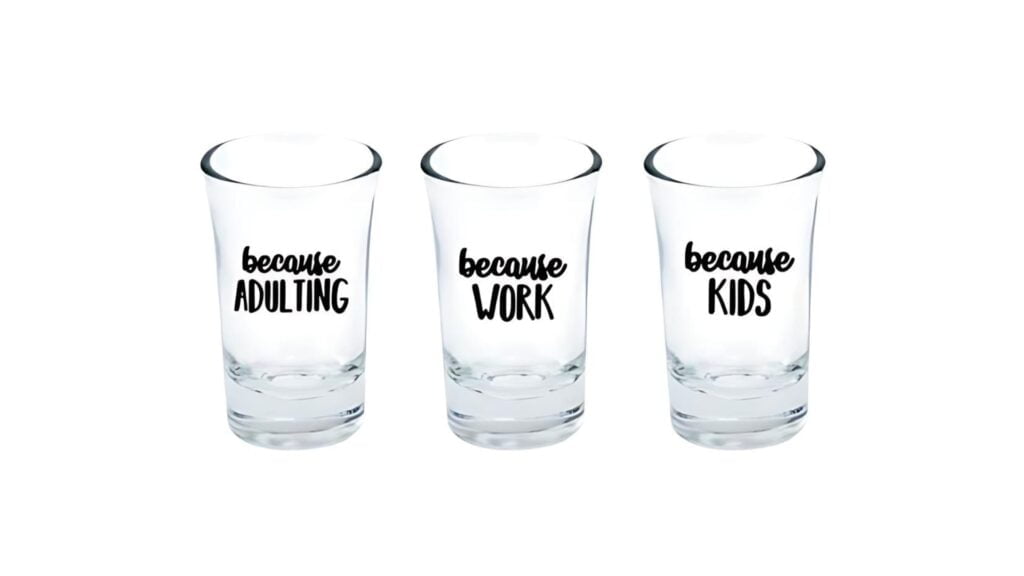
Novelty shot glasses are designed to be eye-catching and unique, often resembling boots, skulls, or famous cultural icons. These glasses are popular as promotional items, gifts, or collectibles.
While they may not be the most practical for everyday use, novelty shot glasses can add a fun and whimsical touch to a party or home bar setup.
4. Standard Shot Glasses

Standard shot glasses are the most common and recognizable type. They feature a simple, robust design that has remained unchanged for decades.
These glasses are typically cylindrical or slightly tapered, with a thick base to withstand the impact of being set down firmly on a bar top.
5. Miniature Shot Glasses
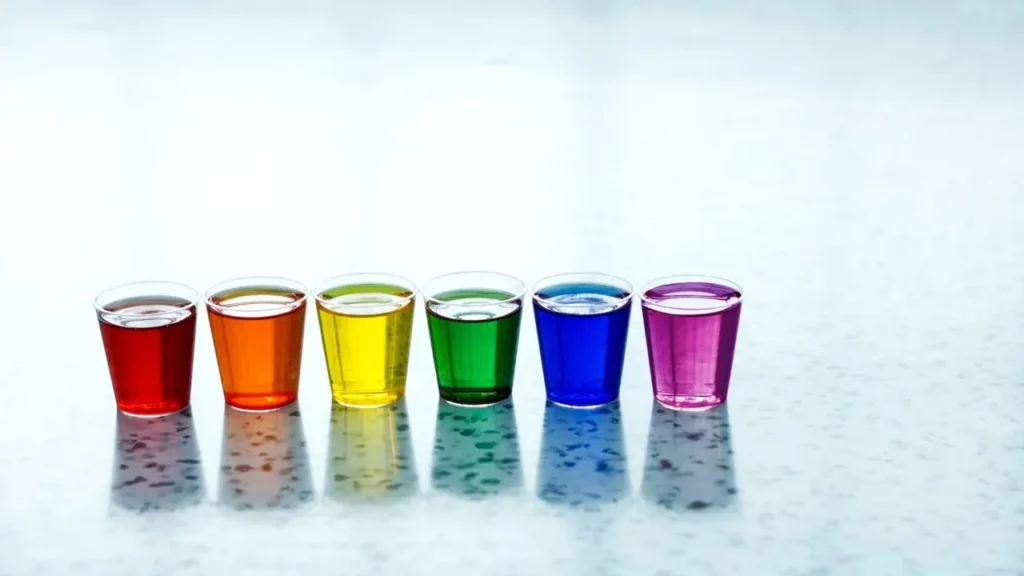
Miniature shot glasses, also known as “mini shots” or “pony shots,” are smaller versions of the standard shot glasses. They typically hold between 0.5 and 1 ounce (15 to 30 ml) of liquid.
These tiny glasses are often used for serving small samples of spirits, liqueurs, or even desserts.
They are also popular as novelty items or for creating “flight” tastings, where customers can try several different spirits or cocktails in smaller quantities.
6. Themed Shot Glasses

Some shot glasses, such as vodka or tequila, are designed for specific drinks.
These glasses may feature unique shapes or embellishments that enhance the drinking experience or pay homage to the liquor’s cultural origins.
Choosing the Right Shot Glass for Your Beverage
| Beverage | Recommended Shot Glass Type | Characteristics | Why It’s Suitable |
|---|---|---|---|
| Tequila | Shorter, wider glasses | Wide mouth, typically holds 1.5 to 2 ounces | Enhances quick consumption and appreciation of flavors |
| Vodka | Clear, thin-walled shot glasses | Thin walls designed to keep drinks chilled | Preserves subtle flavors and minimizes harshness |
| Whiskey | Thicker, more robust glasses | Thick walls, often slightly larger | Allows for better evaluation of color and consistency |
| Rum | Short, wide glasses similar to tequila shot glasses | Short and stout, it can vary in design | Suitable for highlighting sweetness and spice notes |
| Gin | Tall, narrow shot glasses (e.g., shooters) | Tall and slim, usually 1.5 to 2 ounces | Focuses the botanical aromas, enhancing flavor |
| Liqueurs | Smaller, decorative shot glasses | Ornate designs, smaller than standard shot glasses | Complements the variety and complexity of liqueurs |
| Schnapps | Tapered shot glasses or fluted glasses | Tapered design or fluted for aroma concentration | Enhances the fruity and spicy notes of schnapps |
Shot Glasses- Material Varieties
1. Glass
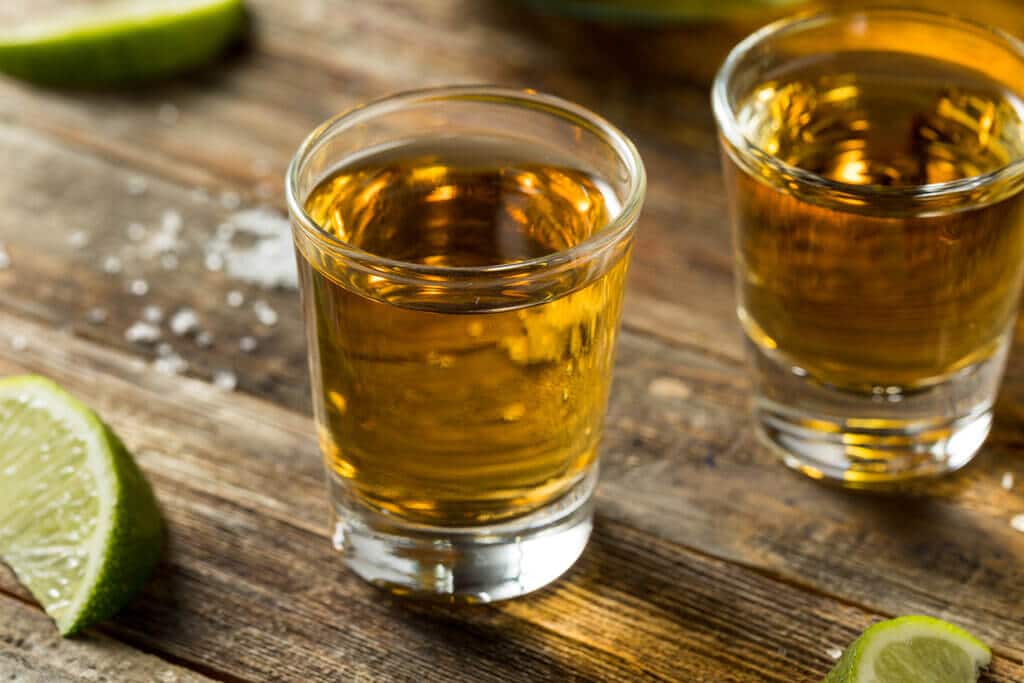
Glass is the traditional material for shot glasses, offering a classic aesthetic that is timeless and versatile. Glass shot glasses are generally inexpensive unless they are crafted from high-quality crystal or feature intricate designs.
They are also easy to clean and maintain, making them a popular choice for home and professional use.
2. Plastic
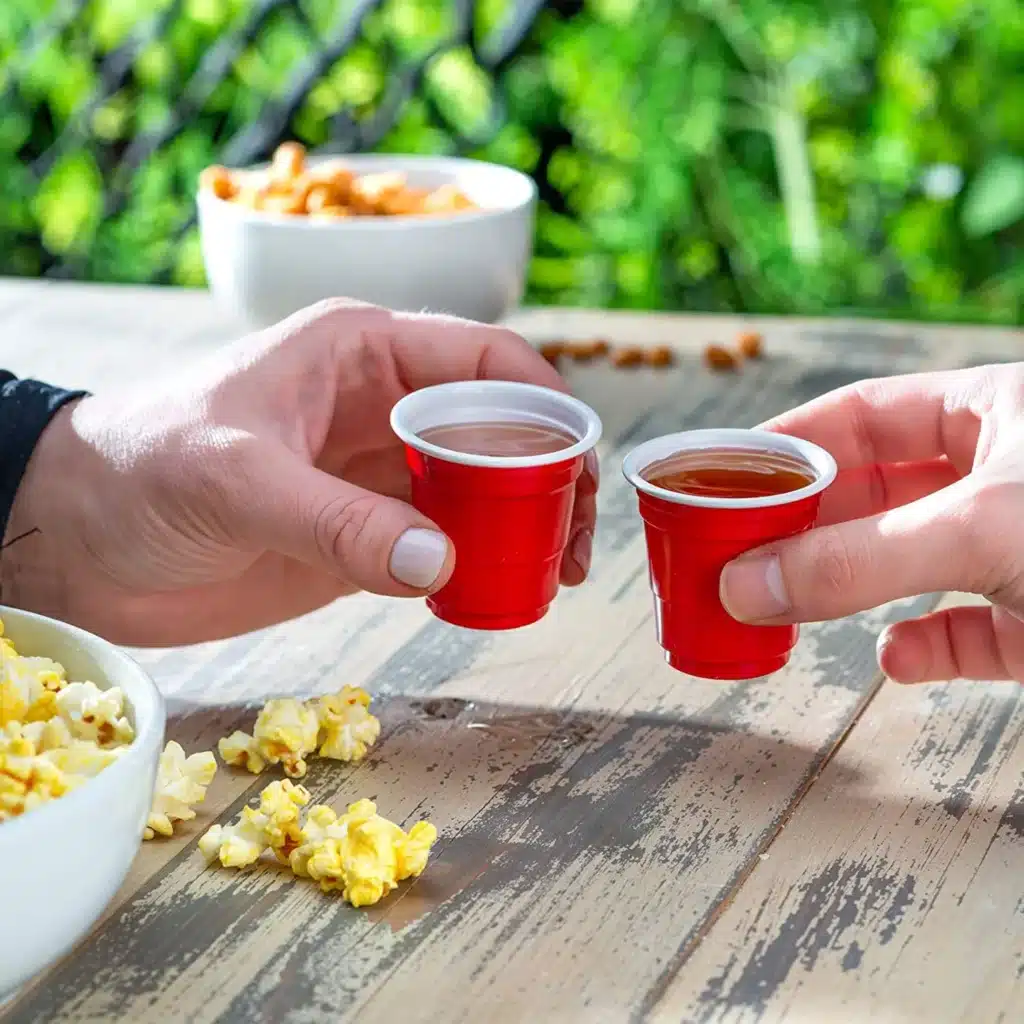
Plastic shot glasses are a durable and cost-effective option. They are often used for large events or outdoor gatherings where breakage could be a concern.
They are lightweight, stackable, and available in various colors and designs. However, some may find that plastic shot glasses affect the drink’s taste and are less environmentally friendly than other materials.
3. Ceramic
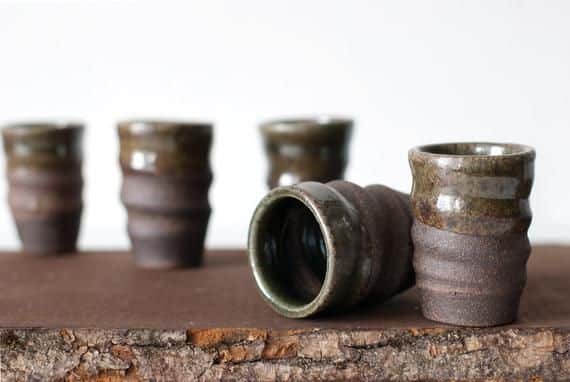
Ceramic shot glasses offer a unique aesthetic option with endless possibilities for colors, patterns, and designs. They are excellent at retaining temperature and keeping chilled drinks cold for longer.
Ceramic shot glasses are often more decorative and can add a personal touch to a home bar collection. However, they are more fragile than glass or plastic and may require more careful handling.
4. Acrylic and Stainless Steel
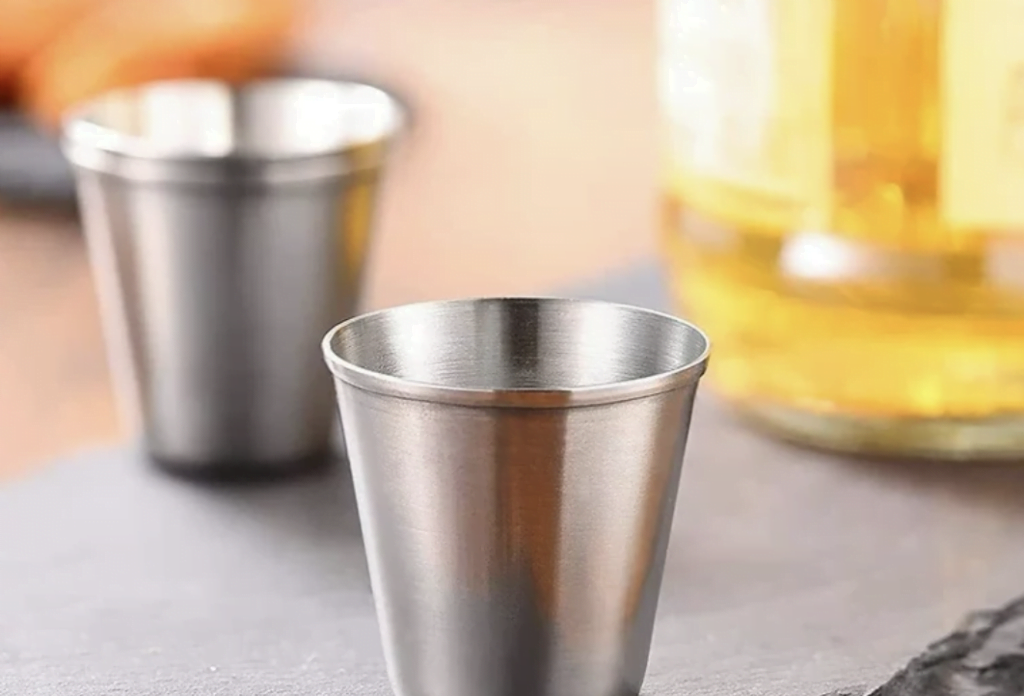
Acrylic shot glasses provide a glass-like appearance with greater durability, making them a good choice for outdoor or high-volume use.
Stainless steel shot glasses, on the other hand, are valued for their sleek, modern look and exceptional sturdiness. They are virtually unbreakable and can keep drinks cold for extended periods.
However, acrylic and stainless steel may affect the taste of certain spirits, and some people prefer the traditional feel of glass.
Uses of Shot Glasses
Shot glasses are versatile and can be found in different settings, serving various purposes:
1. Bars and Restaurants
In bars and restaurants, shot glasses are essential for accurately dispensing liquor and maintaining consistency in cocktail recipes.
Bartenders rely on shot glasses to ensure each drink contains the correct amount of alcohol, creating a balanced and enjoyable experience for customers.
2. Home Use
Shot glasses are also popular for personal use during social gatherings and parties.
They allow hosts to serve small portions of spirits to their guests, making it easier to control alcohol consumption and enabling guests to try various drinks throughout the event.
3. Collectibles
Many people collect unique or custom shot glasses as a hobby. These collectibles can feature anything from tourist landmarks to branded logos, serving as souvenirs or conversation starters.
Some collectors focus on specific themes, such as shot glasses from different countries or those featuring their favorite sports teams.
Conclusion
Understanding the various types and sizes of shot glasses is essential for creating the perfect drinking experience, whether you’re a professional bartender or a home mixologist.
From the classic standard shot glass to the precision-focused jigger and the fun miniature shot glass, each type serves a specific purpose and can enhance your enjoyment of spirits and cocktails.
Considering material, capacity, and design, you can choose the best-shot glass for any occasion.
As you explore the world of shot glasses, remember to drink responsibly and savor the flavors and craftsmanship that go into every sip.
With this ultimate guide to shot glass sizes, you’re now equipped with the knowledge to confidently navigate the world of spirits and create memorable drinking experiences for yourself and your guests.
Frequently Asked Questions
Is a Shot Glass 2 Tablespoons?
A standard shot glass holds 3 tablespoons (1.5 ounces).
Is a Jigger Equal to a Shot Glass?
A jigger is typically larger than a shot glass, holding 1.5 to 2 ounces.
Is a Vodka Cap a Shot?
A vodka cap is not a standard shot measure.

